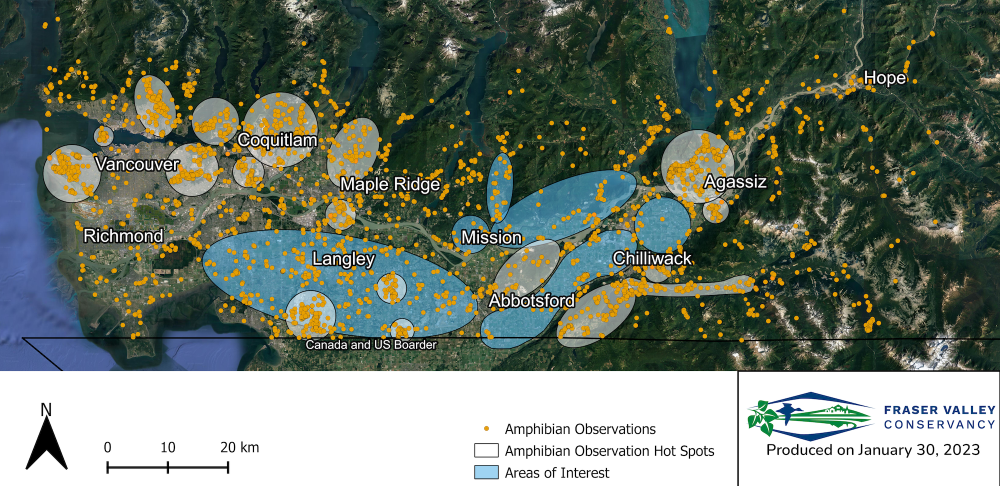Joelle Krol has a March 24, 2023 article in The Tyee (an online publication named after a type of salmon) about a frog project in British Columbia’s Fraser Valley (Canada),
As a junior biologist working for the Fraser Valley Conservancy, I’ve been working on putting together a map of our frog and salamander observations. So much of this data is collected by citizen scientists, who submit their photos or videos to programs like iNaturalist or Fraser Valley Conservancy’s Frog Finders program.
The conservancy focuses a lot of our efforts on amphibians. We do annual surveys in the spring, searching wetlands for frogs and salamanders. We also make efforts to protect and enhance their habitat. But before any of these activities can happen, we need to know where they are. That’s where all these amphibian observations come in.
Thousands of the points on the map started as photos, videos and audio clips that were submitted by citizens — and I’m hoping that if you live in Metro Vancouver, I can convince you to do some citizen science, too. Looking through all the data, you learn how much of an impact a single photo can have.
…
I found that huge portions of the Fraser Valley are lacking amphibian observations, but other portions are rich with amphibians. From here, I was able to identify “amphibian observation hot spots.” These are areas where many amphibians have been sighted and reported. I also identified areas of interest — where there haven’t been many observations but could be great for amphibians. Many of the hot spots surround public parks or protected areas. Whereas many of the areas of interest contain private land.
…

Here’s the request or call to action from a March 9, 2023 Fraser Valley Conservancy (FVC) news release by Joelle Krol, which originated the article in The Tyee,
Ryder Lake provides a great example of how a picture can make a big difference. Residents of the community noticed toads dying on the roadways that sit between the forest and the wetland. They reported these sightings and reached out for help, which got the conservancy involved.
Because of these reports from the community, the FVC was able to tell which location along the road would be the best place to build a tunnel for the toads. Projects like this make a huge difference for the toads’ survival and wouldn’t be possible without those initial citizen reports.
So many strategies for protecting wildlife begin with citizen science data. While there are a decent number of observations in parks and protected wildlife areas, there are shockingly few on private land. It’s not that amphibians aren’t there, but that they aren’t being reported. That’s where you and your photos come in. Submitting photos to citizen science programs helps to fill the map and can result in real change.
You can find a form on the FVC’s home page so you can submit your sighting. If you want to preview the form, you can find it here.